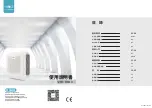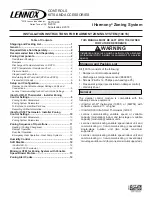
2
110519
OPEN WINDOWS TO EXHAUST AIR
An often misunderstood concept of evaporative cooling is the
amount of air that should be exhausted. How much should
you open your windows? The fact is that most people do not
open their windows enough. The following two methods will
help you determine the amount to open your windows.
FIRST METHOD
You should allow an opening of at least 2 square feet (288
square inches) for each 1000 CFM rating of your unit.
Example:
At 3077 CFM, model 4300 DM requires 6.2 square
feet (886 square inches) of opening (3077/1000 * 2 = 6.2).
Multiply the number of windows by window width in inches
and divide this into the number of square inches required for
your size unit. This will give you the height to open windows.
In this example, four 36 inch wide windows should be opened
6.2 inches each.
CHAMPION AIR BALANCING METHOD
1. Take a piece of tissue paper and cut it lengthwise into 3
equal strips.
2. Turn your cooler on high cool.
3. Open one window at least six inches wide in each room
that you want to cool.
4. Take the piece of tissue paper and put it up against the
screen of the open window furthest from the cooler dis-
charge opening. Let go of it. It will do one of three things.
IF
It falls down.
THEN
CLOSE all of the windows one inch and try step 4
again.
IF
It plasters itself to the screen.
THEN
OPEN all of the windows one inch and try step 4
again.
IF
It stays on the screen lightly.
THEN
PERFECT. You are done. Enjoy your cooler.
NOTES:
• When switching to low cool, you must rebalance your home.
Repeat step 4.
• Once you balance your home you can cool some areas more
than others by opening those windows more and closing the
others by the same amount. Repeat step 4 to make sure
your home is still air balanced.
INSTALLATION
NOTE:
The pump and float are installed in the cabinet. The
belt, motor pulley, and motor cord are included in the cabinet,
the motor is shipped separately.
CAUTION:
Make sure that the mounting surface is
strong enough to support the operating weight of the
cooler when in use. (For operating weight, see
Specification Table.)
CAUTION:
Never plug in cooler until installation is
complete and unit has been tested for rigidity.
MOTOR INSTALLATION
•
Install motor cord.
Connect motor cord to motor using the
following color code: Black - Hi, Red - Low, White - Com.,
Green - Ground.
WATER CONNECTION
•
Install overflow assembly.
Remove nut and place nipple
through the hole in the pan, with the rubber washer between
the pan and the head of the drain nipple (Fig. 5). Screw on
nut and draw up tight against bot-
tom of pan. Insert overflow pipe in
nipple to retain water. Overflow
pipe may be removed to drain pan
when necessary. A garden hose
may be screwed on the drain
nipple to drain water away from
your unit.
RUBBER WASHER
OVERFLOW PIPE
NIPPLE
BOTTOM PAN
NUT
FIG. 5
MOTOR
CLIPS
ADJUSTABLE
YOKE
FIG. 1
BLOWER
HOUSING
MOTOR
PULLEY
BLOWER
PULLEY
FIG. 2
•
Mount motor.
Install blower motor in the motor mount yokes,
adjusting the yoke if necessary. Fasten with the provided
mounting clips (see Fig. 1).
•
Install pulley.
Install the adjustable motor pulley so that it
aligns with the blower drive pulley (see Fig. 2) and tighten
set screw.
ELECTRICAL INSTALLATION
WARNING:
Disconnect all electrical service that will
be used for this unit before you begin the installation.
•
Remove junction box.
The electrical junction
box is located in the up-
per inside corner of the
cooler cabinet. Re-
move the two screws
and slide cover down for
access to plug wiring (Fig. 3).
•
Hook up electrical.
Electrical hook up should be done by a
qualified electrician, so that all electrical wiring will conform
to your local standards. See Fig. 4 for the wiring diagram.
IMPORTANT:
When a single speed motor is used, do not
use the red lead on the receptacle and motor plug wiring.
Tape off end of both of the red leads.
WARNING:
Make sure that cooler cabinet is properly
grounded to a suitable ground connection for maximum
safety.
SCREWS
FIG. 3
JUNCTION
BOX
BLACK
RED
GREEN
WHITE
BLACK/BLUE
HI
LO
COM.
PUMP
GROUND
TO SWITCH
WHITE
GREEN
GROUND
115 VOLTS
60 HERTZ
FIG. 4






























